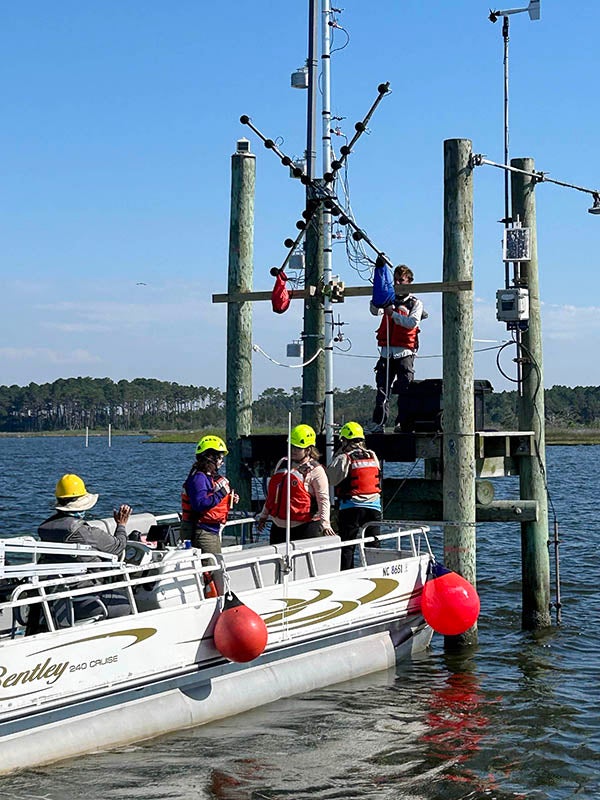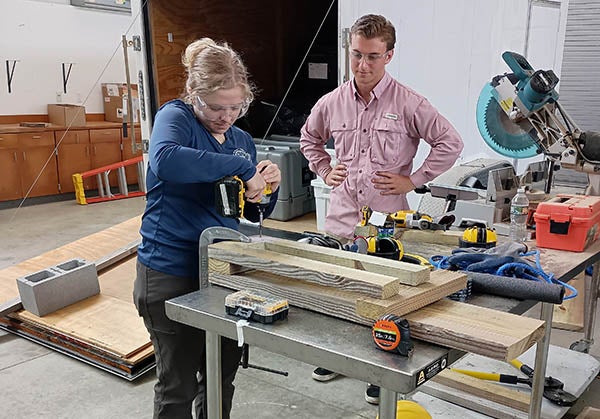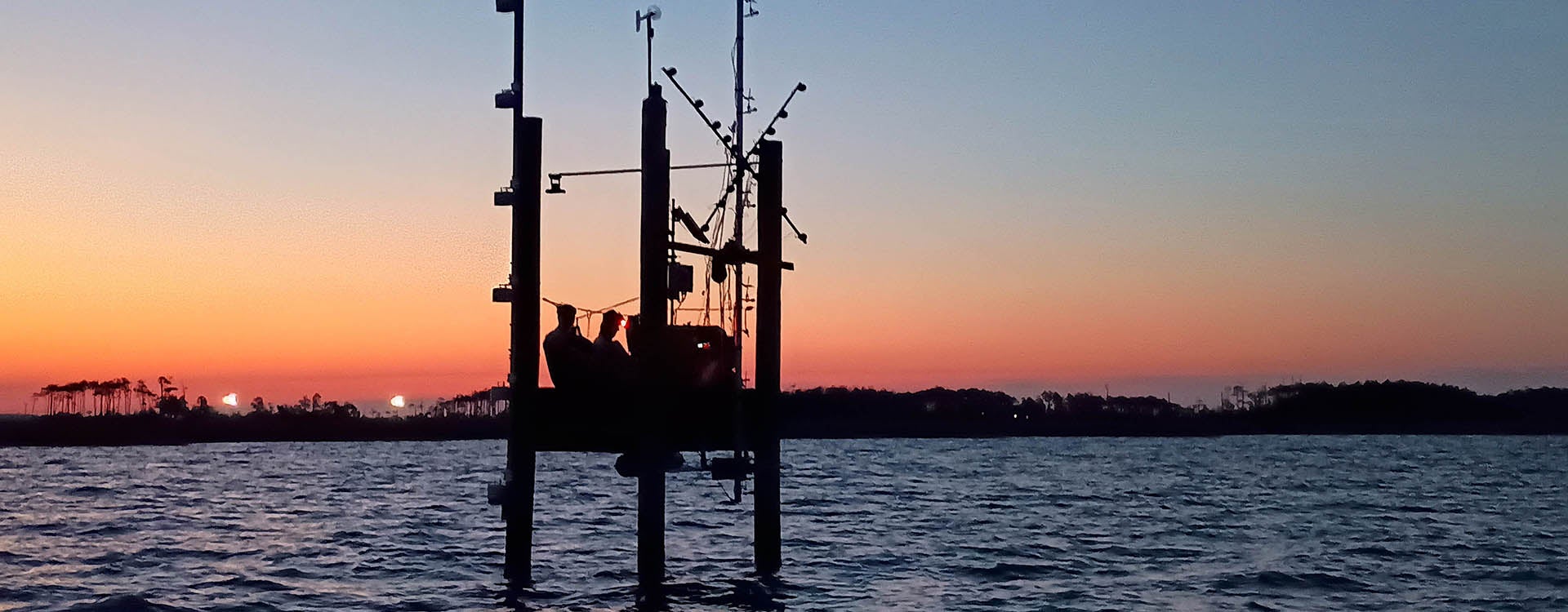Summer Sounds
Engineering students participate in research field work at Outer Banks Campus
A summer along the North Carolina coast sounded too good to pass up for eight East Carolina University engineering students conducting field work for a research project on near-shore atmospheric acoustics.
“This research is helping me develop my resume by showing that I am able to apply principles of mechanical engineering, more specifically those of acoustics and vibrations, to real-world problems,” said Heath Faircloth Jr., a junior from Roseboro. “Having research as an undergraduate will also make me a more competitive candidate for a master’s program if I choose to continue my education.”

Engineering students use a boat to access a platform to work on research equipment near ECU’s Outer Banks Campus in Wanchese. (Contributed photo)
Dr. Teresa Ryan, professor and director of engineering research in ECU’s Department of Engineering, put together a team to work on improving how to predict outdoor sound propagation. The effort includes the development of an improved computer prediction algorithm and the collection of experimental data that allows validation of the predictions.
That data collection is why Ryan, senior teaching instructor Jeff Foeller and the eight students spent a month at ECU’s Outer Banks Campus in Wanchese earlier this summer. They recorded hours of controlled acoustic propagation data at different ranges in different weather conditions and at different times of the day.
“The measurements allow us to see the actual influence of these different factors on how loud the tones are and compare them to the predicted influence of computer simulations,” Ryan said. “Understanding under what conditions the computer simulation works well or not helps us refine the simulation.”
Ryan said the goal is to reliably predict how loud a noise source would be at given distances away from the source.
“This can assist in urban planning for noise abatement from industrial or transportation sources,” Ryan said, citing an example of plans for a housing subdivision near a major highway.
The project — “Experimental Characterization of Near-Shore Atmospheric Acoustics” — is part of a three-year, $343,781 grant from the Office of Naval Research. Since 2015, Ryan has secured $1.2 million in funding through five separate grants from the Office of Naval Research to study various aspects of atmospheric sound propagation.
A bonus to this summer’s work was the opportunity to collaborate with engineers from Naval Surface Warfare Center-Carderock. ECU master’s engineering student Matthew Stengrim was selected for the airborne acoustics group as part of a summer fellowship. He was tasked with proofing a new microphone array configuration, and Ryan’s work at ECU’s Outer Banks Campus proved a good match.
“This was a good networking opportunity for our students to meet the Navy engineers who visited the field site to help configure their array and a great opportunity to showcase the capability for field work at our ECU Outer Banks Campus,” Ryan said. “… They benefited from having our established deployment and data collection procedures, and our overall project benefits from having a richer data set from their additional recordings. This paves the way for ongoing future plans to capture some unique atmospheric conditions with both arrays.”
Stengrim, from Jacksonville, said he enjoyed being back in North Carolina for a few weeks and working with Ryan as part of his fellowship. His next step is to analyze the data collected from the Outer Banks with hopes of improving the quality of measurements and seeing how the measurements compare to model predictions.

Engineering students Brielle Wagner and Heath Faircloth build an acoustic array support system to collect data as part of the research project. (Contributed photo)
“I’ve enjoyed the challenge of being assigned some responsibility for a project and seeing it through different stages,” Stengrim said of his fellowship.
Ryan said the field work provides students a wealth of experience that is hard to find in the classroom.
“They learn about data quality oversight and rigorous documentation protocols,” Ryan said. “Attention to detail and mindful teamwork are critical for success when operating at whacky times of the day and in sometimes challenging outdoor conditions like choppy water and persistent insects. This team demonstrated a remarkable ability to maintain mission-focused excellence throughout our month together at the coast.”
Brielle Wagner, a senior engineering student from Swansboro, participated in the summer research project for the second year.
“We have a lot of fun but also get things done,” she said. “It’s very rewarding to see our hard work pay off when the data is processed. It’s very interesting how sound travels under different conditions.”
As a second-year undergraduate research assistant, Wagner has been involved in all aspects of the work, from designing and building some of the project’s infrastructure and rigging to deployment of equipment and management of newer students on the team.
“This research is great for personal and professional development,” Wagner said. “It tests your interpersonal skills, problem-solving and leadership abilities. I’ve also learned skills not taught in the typical classroom like how to use different power tools and basic boating skills and maintenance.”
Faircloth is also in his second year as a research assistant on the project.
“I joined this lab because I enjoyed having Dr. Ryan as a teacher and thought she would be a great professor to work under as well,” he said.
Faircloth said the opportunity to spend time along the coast during the summer was a pleasant byproduct of the research.
“Outside of work, I have spent almost every minute at the beach either skimming or surfing,” he said. “I go to the gym when I can, and I enjoy cooking out at the house with friends. I have also done a lot of fishing, either wading out into the sound or going on the pier.”
Other engineering students on the project include Gillian Byrne, Trent Byrum, Kyle Kirwin, Ethan Rountree and Mckinzie Tucker. Ryan’s most recent grant on the project continues into 2025.

Conducting field work at ECU’s Outer Banks Campus provided engineering students some breathtaking sunsets and sunrises. (Contributed photo)
